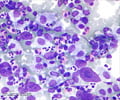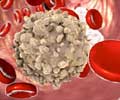Diagnosis and Staging
Diagnosis of Acute Lymphoblastic Leukemia (ALL) is established by using simple blood tests and this is followed by bone marrow test or genetic tests to stage the cancer.
- First and foremost, blood tests are carried out to diagnose or rule out ALL. Some of the parameters studied are:
- Total blood Count
- Different types of blood cells and their count (Differential count)
- Hemoglobin level
- Blood cell morphology
- Immunocytochemistry
- Blood biochemical parameters like electrolytes, Sugars, Creatinine, Urea or BUN, Liver Function Test.
- A bone marrow sample is obtained from the pelvic bone using special needles. Various specialists scrutinize the marrow sample to confirm the diagnosis, to categorize and stage the disease and also to decide on the treatment regimen.
- A lumbar puncture (or spinal tap) may be carried out to see if there are malignant cells in the cerebro-spinal fluid.
- Cytogenetic tests such as a Karyotype or Fluorescent In Situ Hybridization (FISH) may be carried out to identify the chromosomal changes, such as translocations.
- Cytogenetic abnormalities occur in approximately 70% of ALL cases in adults.
- These abnormalities included balanced translocations as occurs in cases of AML.
- However, abnormalities of chromosome number (hypodiploidy, hyperdiploidy) are much more common in ALL than in AML.
Based on the various diagnostic tests, doctors may categorize ALL into six groups. This staging plays a major role in deciding the treatment protocol for affected patients and to also decide on the prognosis.
The stages of ALL include:
- Early pre-B ALL
- Common ALL
- Pre-B-cell ALL
- Mature B-cell ALL (Burkitt leukemia)
- Pre-T-cell ALL
- Mature T-cell ALL














